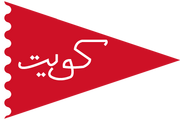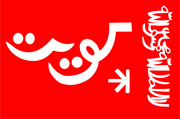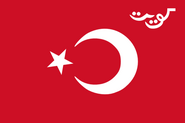The flag of Kuwait consists of three equal horizontal bands of green (top), white, and red with a black trapezoid based on the hoist side.[3]
Symbolism[]
Black symbolizes defeat of the country's enemies; green symbolizes the fertility of the land; red is symbolic of the enemies' bloodshed, and white represents purity.[1]
The symbolism of the colours is associated with a poem written in the 13th century by Ṣafī ad-Dīn al-Ḥilli. He spoke of the green fields of the Arabs, the black battles they face, the white purity of their deeds, and the red blood on their swords. Historically, the first use of those four colours in a modern Arab flag dates from just before World War I.[4]
History[]
The first flag of Kuwait was so called Al Sulaimi flag, it was used by Arabs in the Persian Gulf, and became basis for the contemporary flag of Bahrain.

Standard of the Emir of Kuwait, since 1914

Standard of the Emir of Kuwait, 1956
Kuwaiti vessels used the flag of the Ottoman Empire until November 3, 1914, in order to avoid payment of high customs at the port of Bombay.
From the mid-18th century the Ṣabāḥ family ruled an autonomous territory around the town of Kuwait. When the Ottoman Empire and its ally Germany discussed a Berlin-Baghdad railroad, Britain began to place more emphasis on its links with the Ṣabāḥ family, on the basis of treaties of 1899 and 1909. A few months after the outbreak of World War I, a British ship in the Persian Gulf fired on a Kuwaiti vessel that was flying the Ottoman flag. To avoid similar mistakes in the future, Britain encouraged Kuwait to create a flag of its own. The new flag was red, like most Arab flags in the Persian Gulf, and had the name of the country written on it in white Arabic script. In addition the shahādah (Muslim profession of faith) was sometimes used, with or without the special logo of the Ṣabāḥ family.
The flag had several versions: the emir used triangular flag, the government departments used a square flag, and a rectangular flag was used as ensign.[5]
Kuwait as a British protectorate continued to use that flag until January 22, 1956, when the shahādah and dynastic Ṣabāḥ logo were formally established as part of the design. Five years later Kuwait obtained its independence on June 19, 1961; on October 24, 1961, a new national flag of a more modern design was hoisted, and it continues to be used today.[4]
References[]
- ↑ 1.0 1.1 Kuwait flag at WorldAtlas.Com
- ↑ Kuwait at World Flag database
- ↑ Flag of Kuwait at CIA World Factbook
- ↑ 4.0 4.1 Kuwait, flag of. (2009). In Encyclopædia Britannica. Retrieved April 04, 2009, from Encyclopædia Britannica Online
- ↑ علم دولة الكويت on the site of the Ministry of Education of Kuwait
Asia
|
|---|
| Nations Transcontinental Nations Nations with limited/no recognition Territories |






